Many thanks to SWLing Post contributor, Aaron Kuhn, who shares the following guest post:
XHDATA D-328 Radio Review
by Aaron Kuhn
Disclosure: This radio was supplied at a 99% discount by the manufacturer, costing me only $0.15.
About Me
I live in the Philadelphia Suburbs, where there’s ample FM Stations, good AM Coverage, and also a lot of noise when it comes to Shortwave. I’m mostly an AM/FM listener, who occasionally likes to dabble in Shortwave. My idea of a good radio is something I can turn on, put up the antenna, and it just works.
Initial Impressions
The Radio is boxed simply enough in a cardboard box, with a small amount of bubble wrap inside, manual, Mini-USB Cable. The Lithium-Ion Battery comes pre-installed.
Operation of the radio is mostly straight-forward, and I doubt you’ll need the manual for anything. The manual itself contains your normal badly-translated English phrases and doesn’t make sense in a lot of places (did you know this radio uses high quality PU edge big size?)
Two curious notes about the manual:
- It mentions you should remove the “18650 Lithium Ion Battery”, but this radio doesn’t use an 18650 battery. Instead, this radio uses a “BL-5C” Battery, which based on my research looks like it was pretty common on Nokia phones around 2004.
- Someone took white-out to the manual where it says “Set the function switch to the “MP3” position and insert the USB Stick or TF Card, with “USB stick” covered in white out.
The radio itself is made of a slippery, glossy plastic that doesn’t inspire confidence, but also seems to have enough structural stability it doesn’t worry me. I’d guess this radio could take a moderate drop and bounce and be OK, but it’d probably crack if dropped from above waist level.
I ran into a somewhat funny problem trying to insert the included wrist strap into the hole in the back of the radio. Unlike most radios with a wrist strap hole that’s closed off, the wrist strap instead continued down into the radio. That is, the wrist strap “loop” molded in the plastic is actually a hole into the radio. This doesn’t bode well for dirt or other junk getting pushed into the radio accidentally. I was able to eventually get the wrist strap on the loop, but it was far harder than it should have been.
Design
The Lithium Ion battery comes pre-installed in the radio, and the battery door it’s behind seems sturdy enough. Fortunately, there’s really no reason you should ever have to pull the battery out of this radio unless you need to replace it. Running the Battery model # across Google and other sites shows this should be a very cheap battery for you to replace at between $1 and $3.
I very quickly noticed a big glaring design flaw on this radio with the poorly designed, super small kickstand located next to the battery compartment. This small, off to the left kickstand works fine if the radio is on a perfectly level surface like a nightstand, but causes the radio to tilt over if you try to place it on a soft surface like a bed or a pillow. I would have liked to see just one large combination battery door/kickstand if possible across the back of the entire radio.
Design problem number two with the radio became very apparent when trying to extend the telescoping antenna. The antenna butts up against the plastic molding on the back of the radio, meaning you cannot prop the antenna up “Straight” when using the kickstand. This results in the antenna having to angle off at around 45 degrees, which is a bit annoying. My Tecsun PL-310ET doesn’t have this problem due to having a cut-out notch to allow the antenna to be in a more upright position.
The tuning knob has a satisfying amount of resistance to it, and doesn’t spin too quickly or too slow. The volume knob, while smaller, spins freely and also feels solid.
The band selector selects between FM1-2, AM, and SW 1 through 9. The switch to move between these bands has a satisfying amount of click and feedback to it, and isn’t mushy and you likely won’t pick the wrong band. The small window displayed below each band number fills with a small, mechanical, plastic bar attached to the switch. The window and bar were slightly misaligned, making it difficult to tell at a glance which band I had selected.
The tuning bar itself moves smoothly across the band, but the metal extension piece running down the shortwave part of the spectrum tuning was not vertically straight and had a noticeable bend to the lower right.
Weight – this radio is INCREDIBLY light! The choice of a Li-Ion rechargeable battery pays off here, and when I weighed the radio it came in at exactly 160 Grams / 5.7 Ounces. The compact size of this radio and the weight would cause it to easily disappear into a coat pocket and I’d forget I was carrying it. This definitely qualifies as super-portable in my book.
The choice to use Mini-USB instead of Micro-USB on the charging is a questionable one. Micro-USB is the much more common connector you’ll recognize if you’ve bought a Smartphone in the last 3 years, or any other consumer device with a USB connector. Based on my short research, Micro-USB despite being smaller than Mini-USB, offers a number of benefits including increased cycle-count on the number of plugs/unplugs before the connector wears out. I don’t know why XHDATA went with Mini-USB on this, and I’d suggest they move to Micro-USB for future revisions. The Mini-USB, other than being slightly easier to plug in, seems to offer no benefit and is obsolete compared to Micro-USB.
Audio Quality
Wow! While I may have had some hesitations about the radio’s design, I was incredibly surprised by both the loudness and fidelity of the speaker on this radio. The volume was incredibly loud, and the audio did not distort even when I turned this to the highest setting. While a mono speaker, voices on AM were quite clear and nice to listen to, and music on FM Sounded way better than it deserved to sound coming out of a $14 radio.
Plugging in a pair of earbuds (not included) also produced crisp, loud audio, with no noticeable whine or hiss. Volume levels should be more than adequate. Audio came in through both Left and Right earbuds, but I was unable to tell if the output was actually Stereo when listening on FM. The word “stereo” is not mentioned anywhere in documentation, so I would not be surprised to learn this radio is mono-only.
Tuning
I don’t normally use analog radios, so tuning the D-328 was a bit of a challenge. The cramped display provided little feedback, and the crooked tuning bar didn’t help either. FM Stations seemed to be needed to be tuned “high” About 1MHz from where I thought they should be, and AM Stations about 50 KH above where I thought they should land. Tuning Shortwave seemed like a total crapshoot, being fairly imprecise.
I’m mostly an FM/AM Radio listener, and all the usual local suspects popped right in and tuned easily for me. Static between stations is kept very low, and when a station locks in on FM it pops in very clearly. Selectivity between close adjacent stations can be challenging due to the small tuning dial and skewed visual feedback, but I was able to tune in every FM Station I tried.
I am located in the Philadelphia Suburbs, so my usual station for tuning in a weak signal is WPRB 103.9 out of Princeton. I’m happy to report it came in just as clear as it did on my Tecsun PL-310ET, with no trouble finding it.
AM was more of a mixed bag with tuning. Stations I did not expect to come in clearly seemed to pop in with strong signal strength, while the “go-to” AM Test station of KYW 1060 proved surprisingly difficult to locate on the dial. Audio levels on AM were noticeably wider in variance of signal, with some stations proving almost too quiet to listen to.
I’m honestly not much of a Shortwave listener most of the time, so I’m sure some other reviewers will go into much more detail on the Shortwave performance of this radio then I will. My experience tuning around on Shortwave with the D-328 was similar to AM, in that I had a lot of unexpected surprises in strong signals between 6900KHz and 9300KHz. My shortwave listening usually takes place on digital tuning with the Tecsun PL-310ET, so it’s hard to compare analog listening for something I don’t do that often. Tuning was surprisingly easy on the shortwave bands, but seemed frustratingly random where stations would show up.
MP3
Let’s get this out of the way immediately – this radio does not record MP3 files. Instead, sliding the mode selector to “MP3” will let you play files off a “TransFlash” (MicroSD) Card.
I’ll be up front here – this radio is a functional, but not fun to use MP3 player. I tested the MP3 player by loading up a 2GB MicroSD Card I had laying around with some files in a structure similar to the following:
* Root
** File1
** File2
** Folder1
*** Subfolder 1
*** File 3
*** File 4
** Folder2
** File 5
** File 6
** File 7
The first thing you’ll notice when playing MP3s is the “MP3” Light that is Red. And blinks. And blinks. Yes, the red light blinks continuously while playing an MP3 file and you can’t turn it off. This right here would annoy me to no end if I wanted to use this feature
My second problem with using MP3 functionality is that playback without a screen is a throwback to the days of the iPod Shuffle. And if this radio had “shuffle mode”, I’d be OK with that, heck that would even be fun – but there’s no shuffle here, only sequential play.
This radio does seem to follow the expected order of my files in playing them sequentially 1 through 7 across subfolders, but the lack of visual feedback makes it very easy to forget where you’re at and what you’re playing. Pressing and holding the fast forward button does work to fast forward, and rewind through individual mp3 files.
If you want to load up a MicroSD card with some old time radio episodes and play them back – this might be great. But I’d probably ask you why you’d ever want to play MP3 files on this thing. I mean, the feature is there…. But why? There’s much better devices and experiences out there for MP3 Playback rather than loading files onto a MicroSD card to play on a device with no screen. I imagine this might have some utility usages for playing MP3’s when you don’t want to sacrifice more expensive hardware, but I personally can’t see myself getting much usage out of the feature.
Conclusion
At the end of the day I have to ask myself – who exactly is this radio for? The price point and feature set seems to pit this against the very low-end of the AM/FM/SW Market such as the Analog Tecsun R-9012 at $22, and Tivdio Digital tuning units around $18. The inclusion of Shortwave, Mp3 Playback, and USB rechargeable battery gives this a leg up over budget AM/FM units, as well as the competitors mentioned.
Is the DX/radio hobbyist the target market for this radio? I don’t think so. While cheap (and we Shortwave/HAMs are a cheap bunch!), this radio lacks the sophistication or features a DX’er would want.
Is this a good “throw-away” radio for when you don’t want to risk your “Good” Radio? Absolutely. I would not hesitate to toss this in a coat pocket, keep it out in the garage / workshop, or give it away to a friend. My personal use case for this radio will probably end up being I’ll take it to Baseball games to listen to the game on AM / FM while watching the game. If it breaks, I wouldn’t be too sad and would likely shell out another $14 without hesitation for a replacement.
Is this radio for kids? I don’t think so. Given the poor build quality of this, I can’t imagine this lasting very long in a youngsters hands and surviving more than a drop or two. Analog tuning is likely to prove incredibly frustrating to a youngster, and I can’t see anyone but the geekiest of little geeks making use of the MP3 player function.
Would I use this as an emergency radio, shoved in “go-bag” or kept around for winter storms / hurricanes? Probably not. The build quality and lack of standardized AA-Batteries would give me concerns over my ability to power it (though it did work great from a USB PowerBank when I tested) More concerning is I don’t know if I would trust this to still be working when I need it in a stressful situation.
So who is this for? This radio seems more destined / designed for the low-income international market. The price point on this radio is certainly attractive to North American buyers, but I just don’t think the average American radio buyer really wants or needs MP3 MicroSD Playback or Shortwave functionality.
For $14 XHDATA has made good, but not great, little radio. My future suggestions would be:
- Ditch the MP3 functionality – it’s of marginal usefulness
- Seal off the wrist-strap loop hole better
- Fix the case design so the antenna can sit more “upright”, and swing more freely.
- Re-design the kickstand to run the entire length of the radio, possibly doubling up as the battery door if somehow possible
- Switch from Mini-USB, to Micro-USB connector
- The BL-5C Battery is an …. Interesting choice. It sure seems to help with weight, but I think I’d rather see a single 18650 Cell as hinted by the manual or AA’s.
Many thanks, Aaron, for sharing your fine evaluation of the XHDATA D-328! I couldn’t agree with you more regarding your “future suggestions”–sounds like the MP3 functionality has marginal utility and the chassis design could use some tweaks. I’m very surprised a radio made in 2018 still uses a Mini-USB port. And that kickstand? I don’t think I’ve ever seen one more off-center!
But as you conclude, for $13.80 US (Amazon affiliate link), it is a very inexpensive unit. Not one for the radio enthusiast, but one that could please the casual radio listener. It sounds like the audio is surprisingly robust.
Thanks again for your fine review, Aaron!

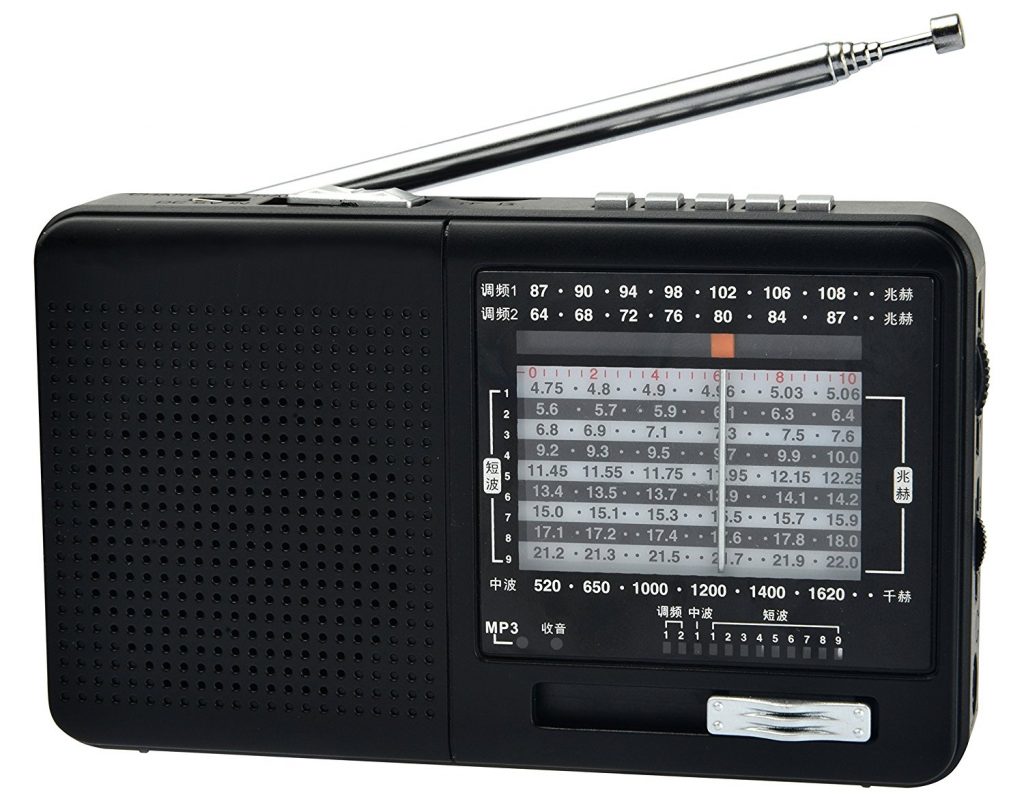
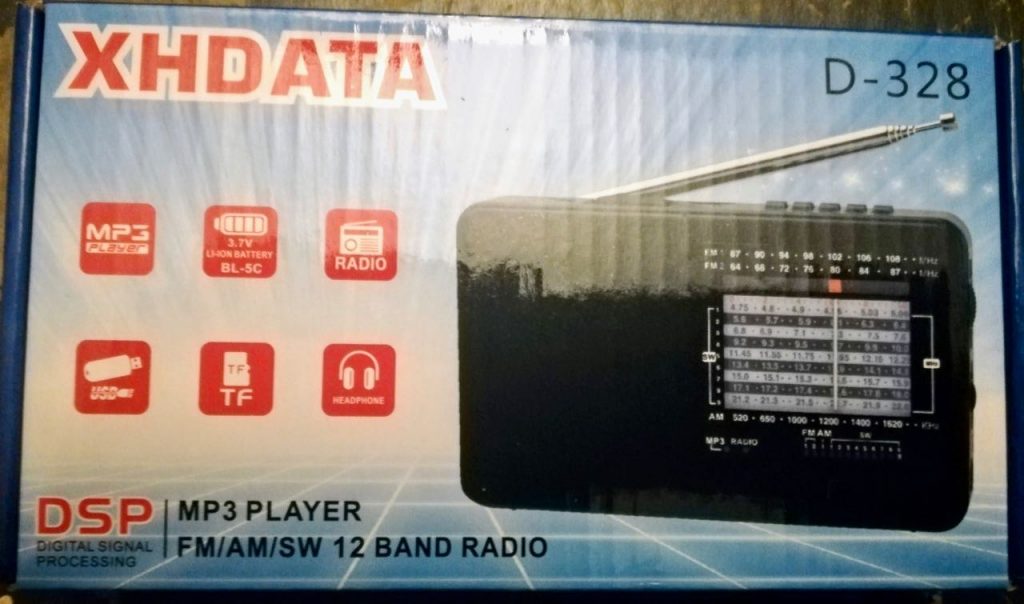
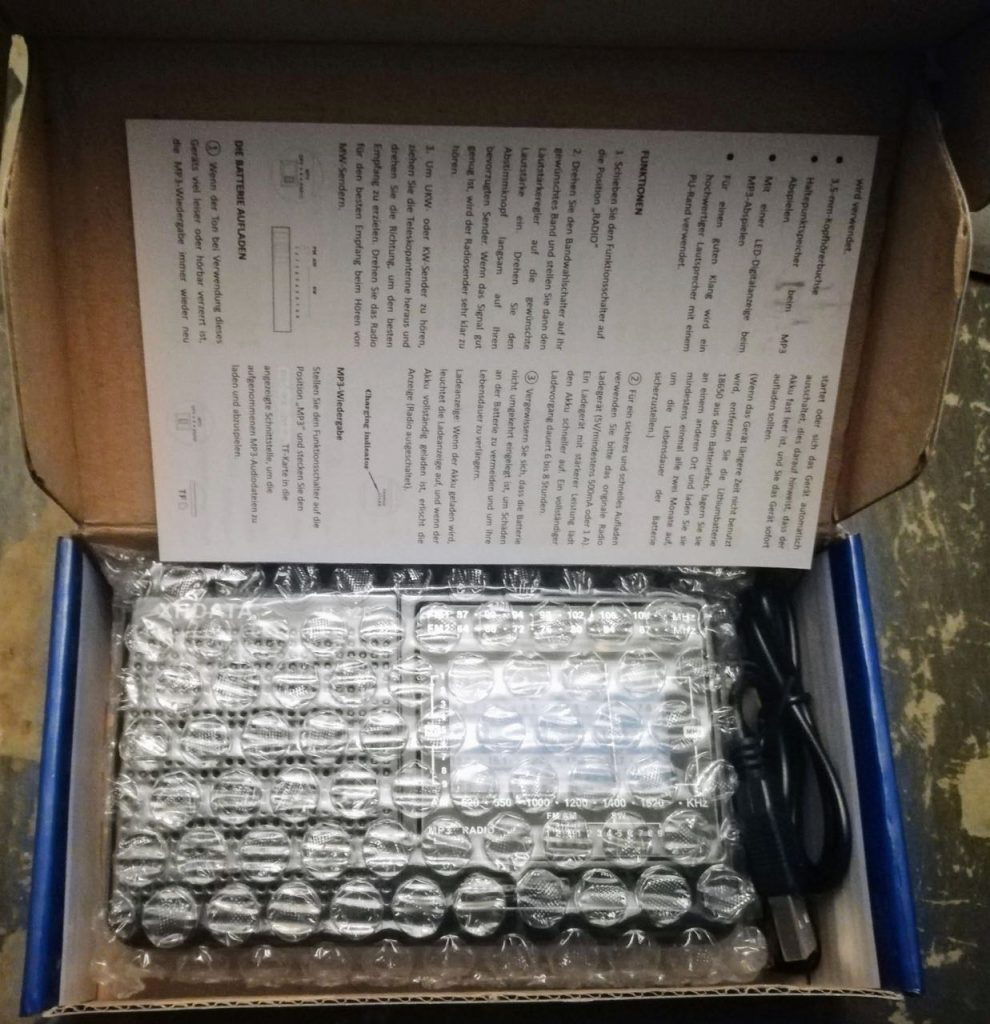
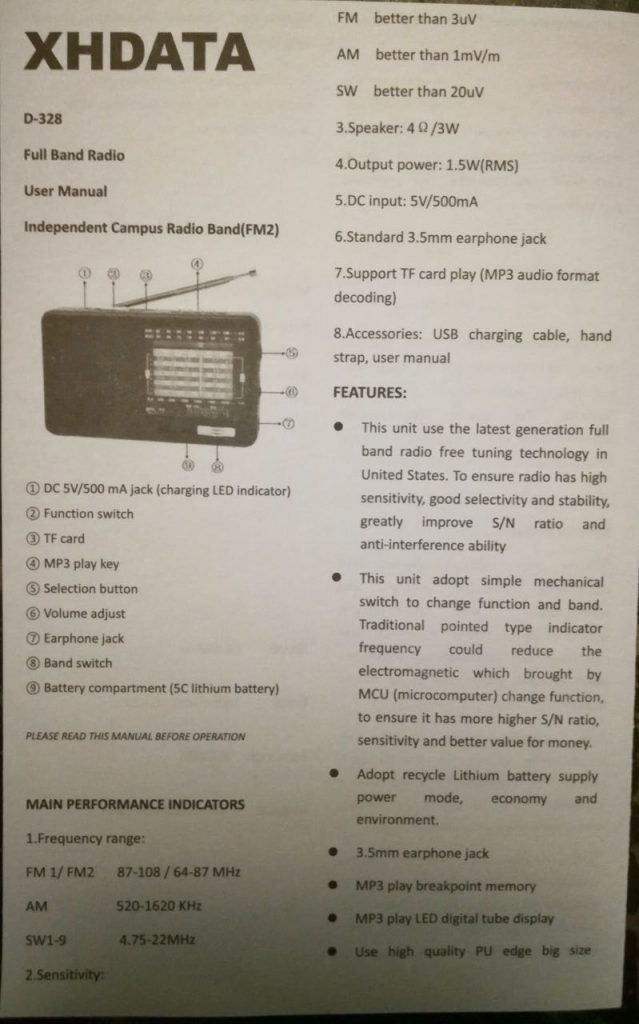
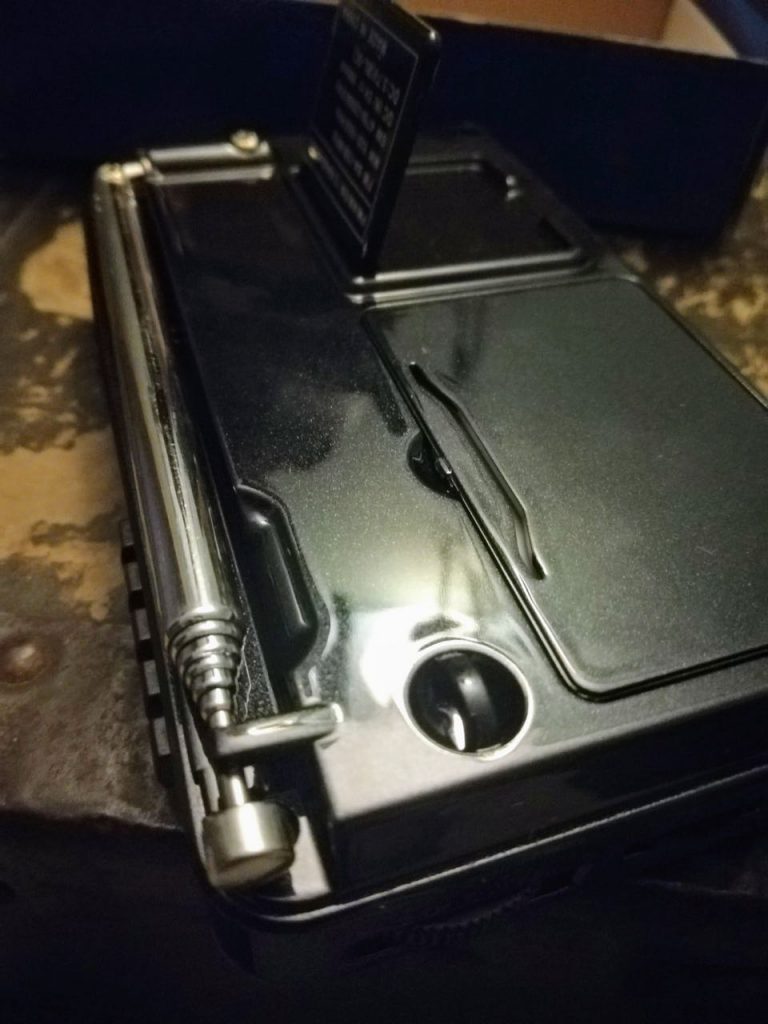
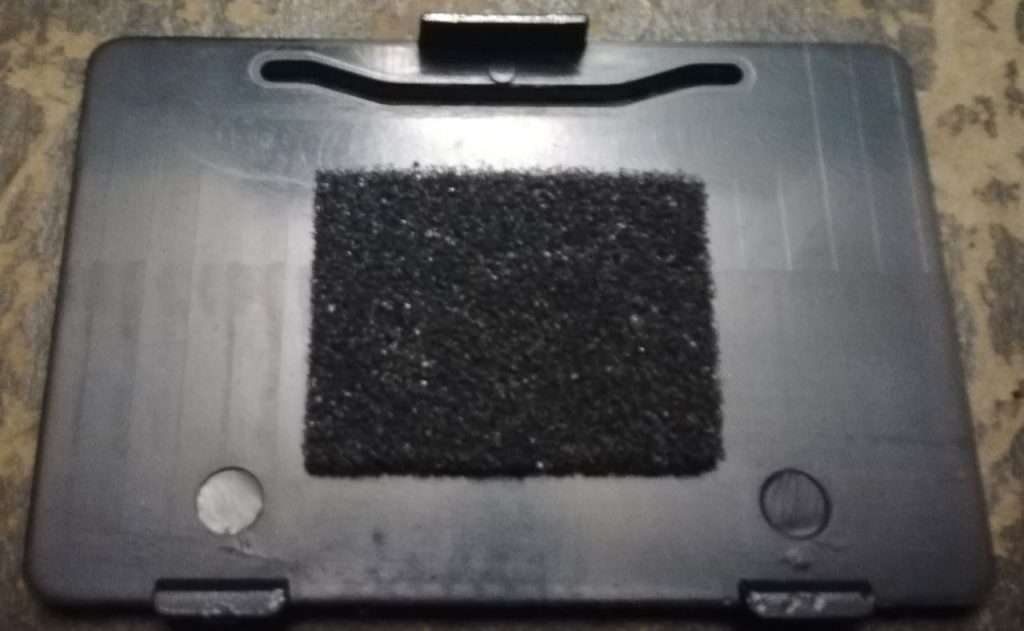
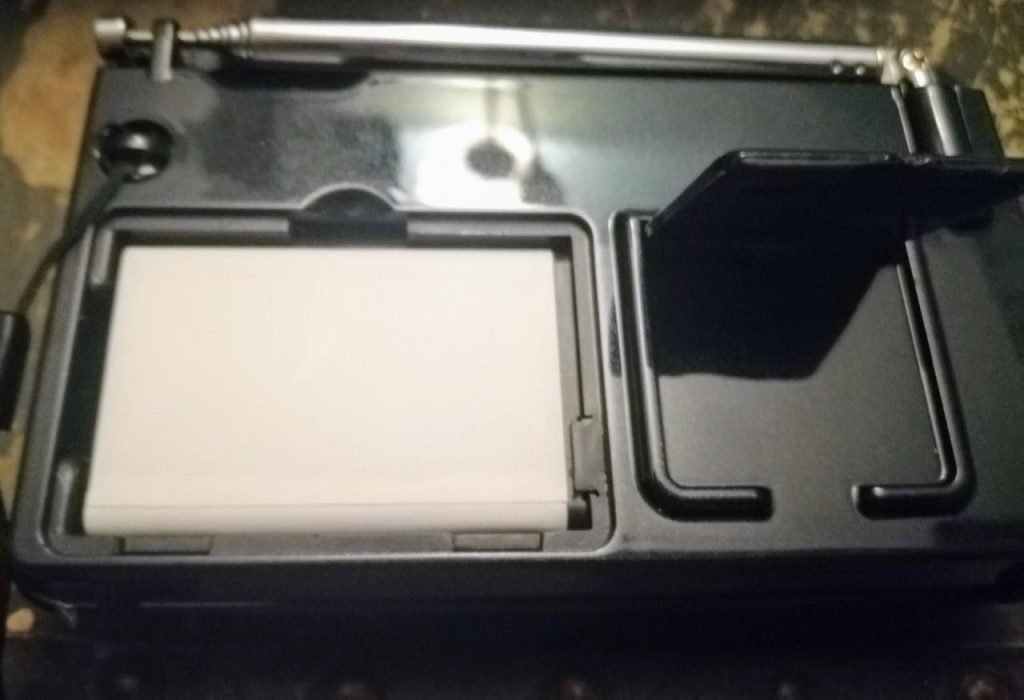
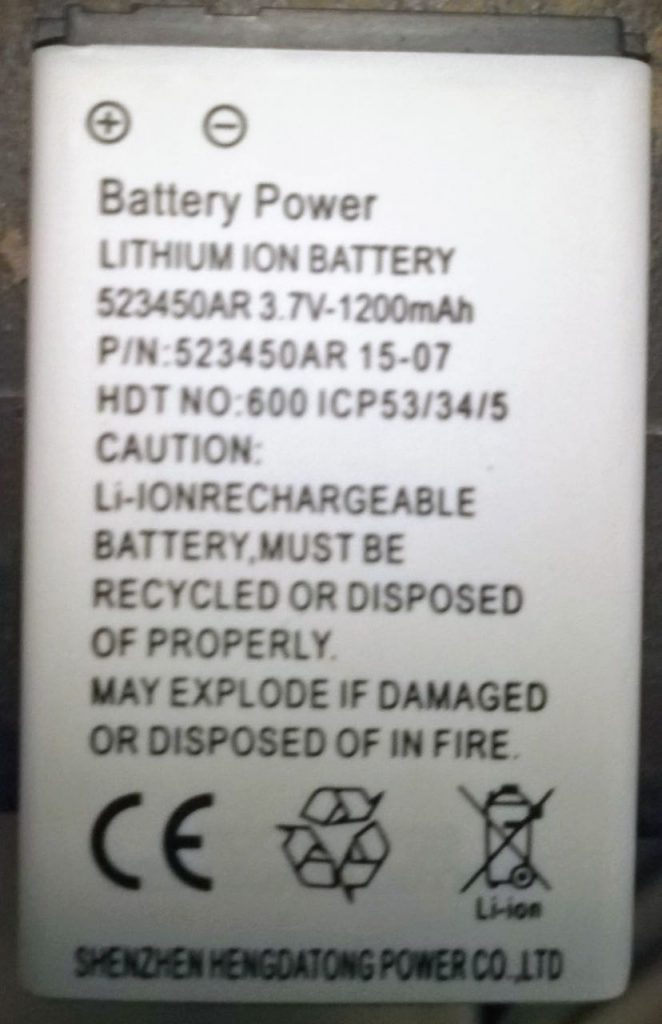
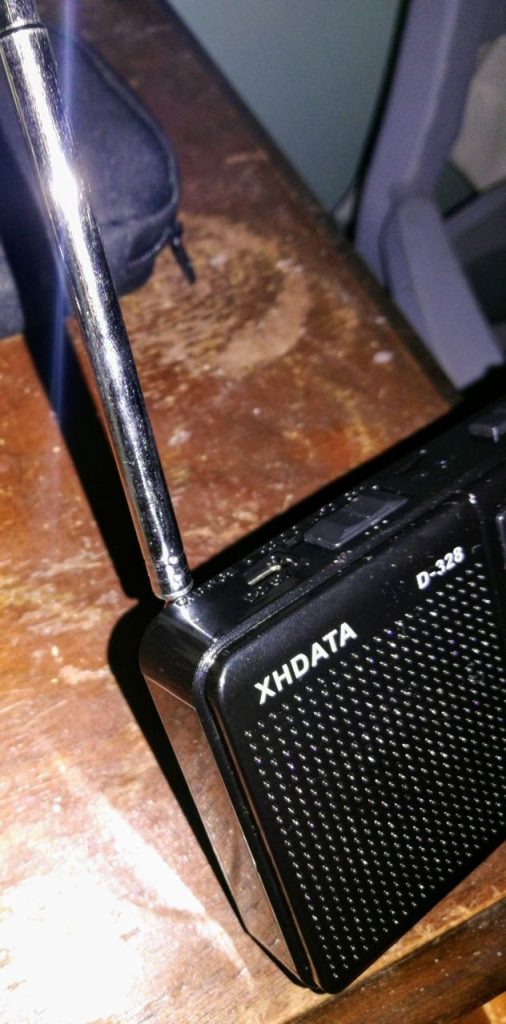
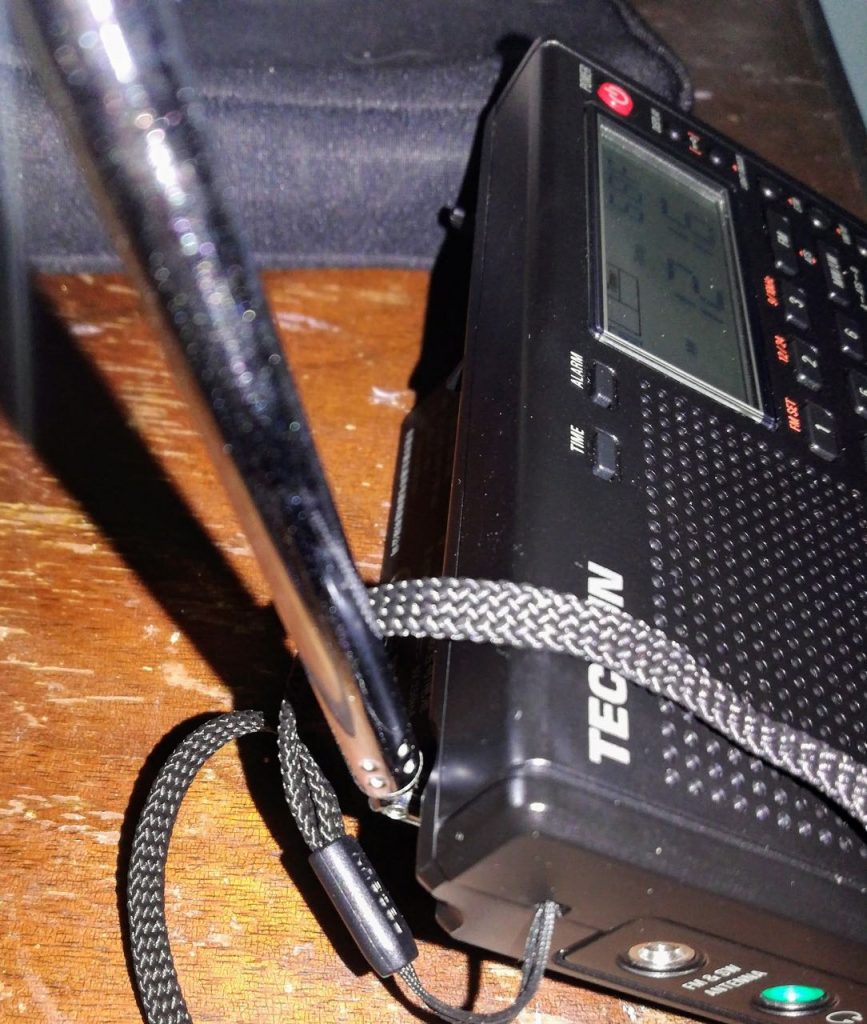

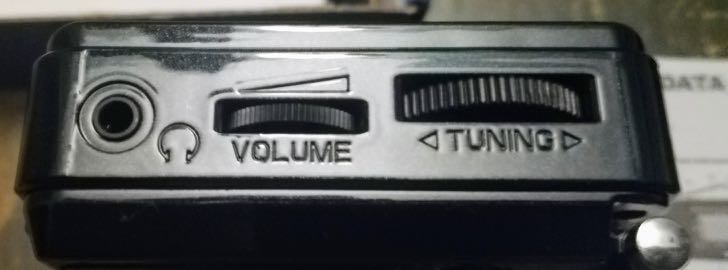
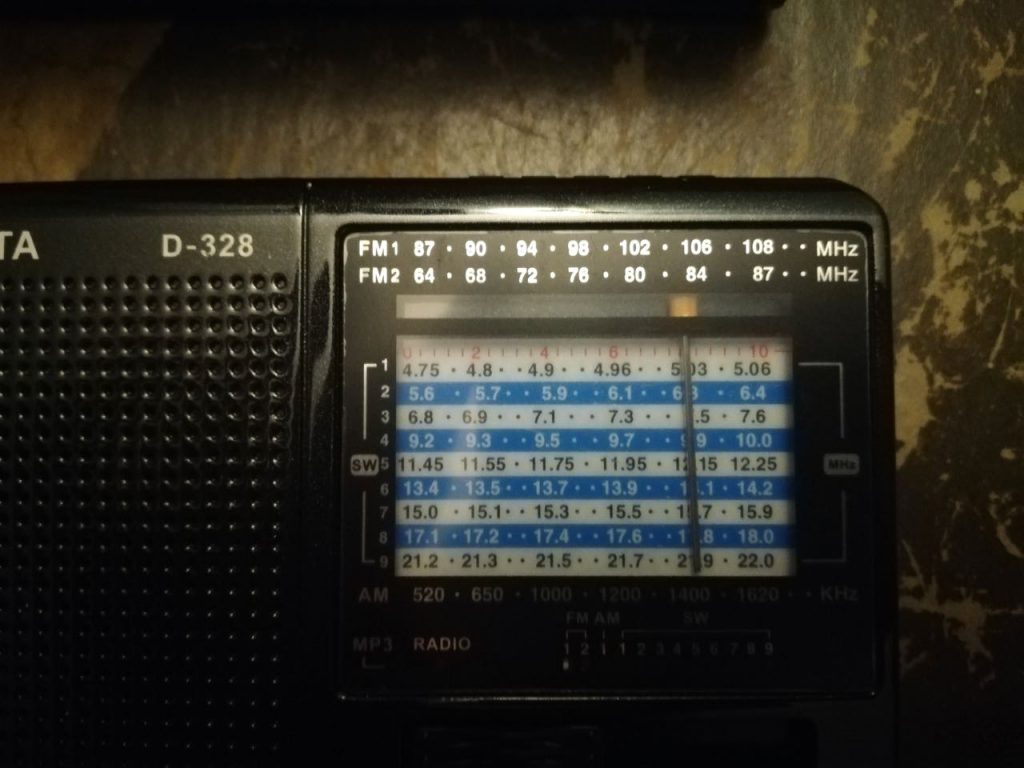
I have a CC Pocket radio and compared it with the XHDATA D328.
On FM, the XHDATA outperformed the CC Pocket,
while on AM, the CC Pocket was better.
However, the CC Pocket does not have SW or MP3.
There isn’t a big difference in size between them,
but the price difference is about ten extra.
The XHDATA D328 is a little beast and a great deal — proof of that is the fact that it’s still being produced to this day.
I must say , for such a light weight radio of this size , the shortwave of this radio is
superb, it brings in far off signals , for shortwave it is as good as my xh
data d808, the medium wave is moderately ok , fm is good , the micro sd card part works
well too. Thought of sharing my feedback, analog radios are old time assets, we have suddenly
grown modern in the last few years and started using digital tuners like xh data d808 for
finding the exact frequency of the stations (my xh data 808 is a very very good radio too)
, but at times when I am not looking for the frequency number of the station, the xh data 328
is an excellent companion, one additional thing to note – with my external antenna the shortwave of this
radio sounds even better . Without external antenna, at times the telescopic antenna does
not need to be fully extended in many cases , even then the short wave stations come quite well.
Overall I am very happy with the radio , I am yet to discover the the full merit of the
medium wave section of the radio, once I see more of its medium wave capabilities I will
let you know 🙂
There is one cabinet design flaw which should be corrected in future versions, there should be a notch for the extended antenna at the back of the cabinet, this will allow the antenna to align in a proper angle while fully extended.
This is a nice radio … For the price.
What really saves this radio however is the sound. The sound is huge and quite bassy !
On the negative sides I would have liked the possibility to use standard aa batteries, a LW band (useful here in Europe).
Because for a little bit more you can have the Super Sonic sc-1080by which is a better deal. Same kind of tuner and specs, but possibility to use aa batteries and it also has Bluetooth. And the sound is better than average.
First off, this is the best radio I’ve ever operated… that cost me less than ten dollars new. When I saw the promotion on the SWL blog for free or half price radios, I had to bite, especially because the deal was that the first ten to respond would get a free XHDATA D-328. They told me I was the 15th caller, so I was allowed one for half price. And since they were going for just under fourteen bucks on Amazon, it felt like it was almost free.
Of course, I didn’t expect much. But as they wanted the people who received these free or very inexpensive little radios to leave reviews, I figured the Chinese manufacturers knew there were some good features radio folk might notice. And there are. And I’m not sure if I’ll post part of this brief review on Amazon, but I’ll do so here in this comment.
If you want a radio that will reliably pick up local AM and FM stations and play some MP3 files, this will work, and work pretty well. And it doesn’t sound bad at all for the size. I personally don’t have much love for these new analog-style tuning DSP radios, but I suppose people who aren’t as radio wise as readers of the SWL Listening Post won’t notice the less than poetic effects of moving between stations on these sets. Most probably tune in their desired stations and just listen to it, and this radio does this well enough.
I don’t really listen to FM much, but the XHDATA D-328 seems adequate enough. And with headphones on it sounds quite rich on FM. AM isn’t bad either, but it’s far from selective. I was able to dig out clear channel regional biggies like Zoomer Radio at 740kHz and WHAS at 840kHz in Louisville from here in Brooklyn at night, but in between often easy to find fifty-thousand watt stations like WBBM or CKLW weren’t there. The DSP tuning just defaulted to the next local station like WNYC or WABC when I turned the dial.
Shortwave was worse. Beyond the U.S. powerhouses like WWCR this radio doesn’t seem a very worthy shortwave set for those of us in North America. But I can imagine in that in third world countries where international and local broadcasters still target broadcasts that this radio might be an inexpensive way to access that programming.
I must admit that listening to MP3 music files was kind of pleasing. Again, the audio is really good for a radio at this price point. However you are listening blind, there’s no screen to tell you what you’re hearing, and no shuffle function to make a folder full of MP3s into unique sequences of songs each time. What you get are the songs in the alphabetical order of the file titles, although you do have the option to jump ahead 10 files before or after the one you are playing. So the best use of an MP3 player like this would be to listen to podcasts or whole radio programs with it. What I would do is copy the files onto the SD card and then perhaps number the filenames in the order I would like to hear the shows.
So, for the price there’s not a lot to complain about. People have already mentioned the off-center small kickstand, and that’s a little cheesy. But the tuning thumb wheel moves smoothly thru the imperfect DSP tuning function, and the volume thumb wheel is actually analog which make it much easier to get the exact volume you want out of this radio. But the sliding band selection switch under the tuning scale is a bit worrisome, as I’ve had a few cheap Chinese radios with a switch like this and just normal use eventually rendered them unable to switch bands adequately. This one feels a little bit more stable then they did, but time will tell.
All that said, there are radios that are not too much more expensive than this radio that offer much more in a number of ways. The small and inexpensive analog Tecsun radios from a few years ago are a case in point. Selling for twenty to thirty dollars, those multi-band radios are a little challenging to tune (a stiff thumb wheel on some), and the tuning scale may be a little off and they may drift a little, but the analog tuning is a much better experience. And you can DX with them. I remember listing to All India Radio with a decent signal one afternoon on my Tecsun R-9710.
There’s a lot of similar analog radios which I believe are probably just about the same radio – the Tecsun R-9012, the Tecsun R-911, the Tecsun R-909 and the Kaito WRX-911, among others. Once you get a look at these you’ll recognize other similar radios in this family. I’d say they’re the best really cheap receivers I know of. They generally run between twenty to just over thirty bucks. I believe these radios appeared on the scene in the early 2000s.
I have this fear that they’ll start turning these radios into DSP sets. That would be a real shame, but I’ve heard no mention of that. However I did notice that the marketers of the XHDATA D-328 didn’t even mention that it was based on a DSP chip. And Chinese manufacturers are notoriously not very open about how they are altering radios that they’re putting out, so be aware of that.
As far as MP3 playback, the one radio I would really recommend is the Meloson (or Tesslor) M8 (or the Meloson M7 or S8 if you can find one). It’s simply the best audio you’ll hear in a really small radio, AND you can shuffle the MP3 files in a folder with these. While it only give you the sequential number of the song in the display, it will generate a unique sequence of songs each time you shuffle. Fill a folder on a card full of songs and let it rip. It’s the perfect micro music player if you make a good folder of music. And the DSP radio in these is not bad either. It’s digital, not fake analog tuning, and most AM clear channel targets you can usually find at night in your region will show up on these. They used to go for less than thirty bucks, but right now I see they cost close to fifty dollars.
Two other radios I have that I can recommend for MP3 playback, are the Tecsun ICR-110 and the Tivdio V-115. Neither one offers playback shuffle, but they will play the files in alphanumeric order just fine. But they both have a cool feature in that you can press a button and record the broadcast you’re hearing as an MP3 file. And they both also sound great. The Tivdio has incredible sound for a tiny radio, but the ICR-110 is even more impressive. I believe it has the same speaker setup as the much more expensive Tecsun PL-880 and it also has similar warm and clear audio.
The reception with the V-115 is OK, nothing stellar, but the ICR-110 is kind of a monster on medium wave. I’ve been impressed. The ICR-110 is rather big compared to the other radios I’ve mentioned, closer to the PL-880 in size, but quite a bit lighter. The ICR-110 used to be cheaper, but can be found for around forty bucks. The Tivdio V-115 still goes for just under twenty if you look around. A bargain. Tecsun, Tivdio, Degen and other Chinese manufacturers have all sorts of inexpensive radios for sale out there, and others I haven’t used or mentioned might be quite good as well. If one appeals to you, do a little online research.
Of course, since I’m talking about small and inexpensive radios I should mention that the Tecsun digital DSP sets like the PL-310ET, the PL-360, PL-380, PL-390 and other variations are all amazing inexpensive radios that will run you around 35 to 50 bucks. The ultralight DX community loves these things, and for good reason. And there’s a version of the PL-390 that plays MP3 files from an SD card and another that offers bluetooth playback. No, none are perfect, but they’re solid sets, and all would have been dream radios thirty years ago.
So, that’s my evaluation of the XHDATA D-328, well worth fourteen dollars, but for a few dollars more you can get radios with similar features that do much more. It’s small, it doesn’t sound bad, and it’s fairly well-built. It will pick up all your favorite local stations and play all your MP3 podcasts effortlessly. Not bad. Like I said, it’s the best super cheap radio I’ve ever used.
Thanks for the review.
I love analogue radios, I love some of their dials and the ability to quickly scan the bands, unfortunately most of them don’t cover out of band transmissions such as 7780 Khz.
But this radio http://tecsunusa.com/radios/tecsun-r-9700dx-sw-mw-high-sensitivity-world-band-radio.html is really good, I love it and it has a backlight display which is dead handy.
The Tecsun R9700 DX also seems far better built than the D-328 and it looks a lot better.
I wish the Japanese made radios again , proper analogue radios made in Japan !
I recently bought a very rare KOYO KTR-1770 on ebay in excellent condition, super sensitive I couldn’t believe it, of course it suffers from imaging from strong Am stations and Ham operators but for it’s age it’s really fantastic, 30 feet of wire on the telescopic really makes it come alive and it also works as the MW antenna ! and I just love tuning those lovely analogue displays and It even has SSB though it’s difficult to tune them in but it’s fun. It’s such a shame they don’t make radios like this today, imagine if they did ?
Thanks for the detailed and thoughtful review of the XHDATA D-328. Hey, any PRC designed and built multiband SW portable that arrives packaged in a silverfish-free corrugated cardboard box is a win. These radios will keep the YouTube shortwave experts busy for months. I heard that these radios are selling like hotcakes in Colombia.
I too asked for one of these review radios, but I wasn’t quite quick enough. Now, I’m a bit glad I didn’t.
This doesn’t sound very useful when compared to basically any other radio out there. If you pay five to ten dollars more, you can get a basic radio from a number of people that will receive more and break less–my go to is the Tivdio V-115, which has five out of six of your requests (it has no kickstand; you have to improvise if you want one). Frankly, it sounds like the basic analog shortwave sets that were made in the 80s and 90s with a basic mp3 player attached, and I have enough things already that can read SD cards. Since you have to have a card available and something to write it, I can’t even see how useful that would be in developing countries, as they are likely either to have something more useful to read the card or no ability to write one. I’m quite underwhelmed.